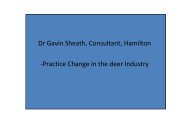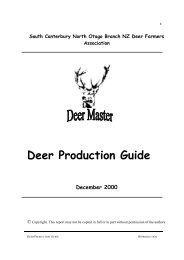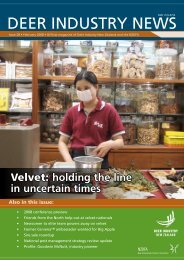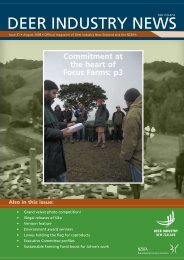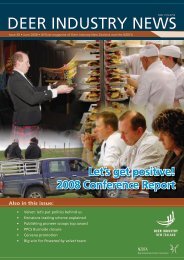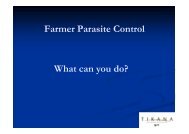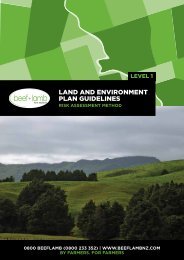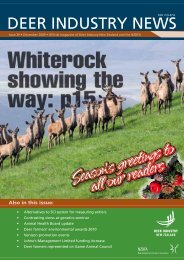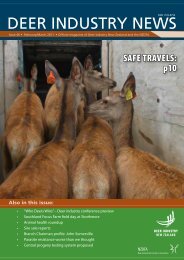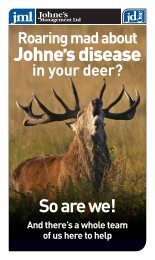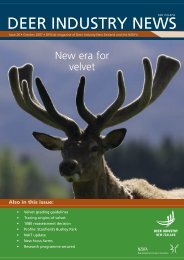Deer Industry News #36 June 2009 - Deer Industry New Zealand
Deer Industry News #36 June 2009 - Deer Industry New Zealand
Deer Industry News #36 June 2009 - Deer Industry New Zealand
- No tags were found...
You also want an ePaper? Increase the reach of your titles
YUMPU automatically turns print PDFs into web optimized ePapers that Google loves.
conferenceTransport and welfareThe last velvet season went very well from a compliancepoint of view, said DINZ Quality Manager, John Tacon.“No-one failed their audit, and this year’s programmeshowed good standards were maintained,” he said.MAF prioritised bobby calves and velvetting programmesfor closer scrutiny last year, and a surveillance programmewas run from September 2008 to January <strong>2009</strong>. A positiveeducational approach had been taken by the regulator, andonly one case has been referred for further investigation. Thesurveillance will be repeated again next season.John reminded farmers that the same rules applied, whetherit was one or 100 deer being velvetted. That said, the NVSBprogramme was delivering what regulators required, headded.John said there had been some confusion about the changein maximum length of velvet antler from 100 to 110 mmfor deer being transported. He said the length could not beextended beyond that without creating ‘headroom’ issuesduring transport.He issued the following useful reminders to help ensure goodwelfare when deer are moved by truck:• things can go wrong on a short or long journey• ensure the deer are fit and healthy• don’t mix deer from different farms or age groups• don’t transport weaned hinds less than 10 days afterweaning• use correct stock densities.<strong>New</strong> <strong>Zealand</strong> has an excellent deer transport QA scheme,John said, and he urged all farmers and transporters to makesure it worked.Focus Farm programme tacklingproduction challengesProducer Manager, Tony Pearse, rounded out the DINZpresentations with an update on the Focus Farm projectsand the Productivity Strategy, which are now all hitting theirstraps.DINZ contributes $30,000 per farm per year with furtherinput from AgResearch, regional councils and othersincluding local sponsors. Tony said the most importantlinkage is between the skilled facilitators, the dedicatedfarming couples and the communities and Branches aroundthem.There has been excellent support at field days, withattendances of more than 100 not uncommon at the majorpublic field days and 40–80 at community days.Major issues identified on the Focus Farms included aserious drop in production levels in first fawners, a lack ofimprovement in productivity despite advances in geneticsand quality, and local challenges including drought and coldwinters, competing land use and time constraints. Managingyoung hinds from weaning through to mating was emergingas one focus for more attention.The farms are also hosting various Sustainable FarmingFund projects including studies of parasitism, tussock landmanagement and development and carbon footprint impacts.Tony noted that relatively modest amounts of industryfunding could leverage large inputs from other sources likethe SFF. Another project is looking at the role of palm kernelextracts in production systems.Excellent linkages with Johne’s Management Ltd, the DiseaseResearch Laboratory and Johne’s Research Group were alsopaying dividends.A new sponsorship from CRT was to support three discussiongroups throughout Otago, he announced with a proposedLandcorp, DINZ and M&WNZ project for the Fiordland/Southland area under development.The first-ever Focus Farms conference held last year yieldedsome important outcomes including the following prioritiesfor Focus Farms:• animal health, especially Johne’s disease status• a better understanding of the impacts of parasitism• better tools for monitoring (farm and communitygroup).The information being generated by the programme wouldalso be captured at next month’s <strong>Deer</strong> <strong>Industry</strong> TechnicalConference (hosted by the <strong>Deer</strong> Branch of NZVA).The programme has identified areas where it can do better,including:• concise take-home messages• keeping focused on profitability• attracting more people into the programme, especiallyyounger farmers• clear programmes and regional relevance• better use of <strong>Deer</strong>Select information and top genetics.Tony said the programme had already led to some bigchanges in strategic thinking, including the use of latesummer and autumn crops and managing animals carefullythrough lactation and weaning.“At the end of the day, our deer all respond to feeding,such a key part of the more, heavier earlier, theme of theprogramme.”Antler, schmantler – when’sdinner? Young CaitlinMitchell finds it all a bitof a yawn during the <strong>Deer</strong><strong>Industry</strong> Conference atPalmerston North.Photo: Rachael Mitchell.20<strong>Deer</strong> <strong>Industry</strong> <strong><strong>New</strong>s</strong>



